Your smartwatch becomes readable in sunlight through ultra-high brightness displays exceeding 1000 nits, reflective LCD technology that harnesses ambient light, and specialized outdoor modes that automatically adjust contrast ratios and color schemes. OLED and Ultra Clear AMOLED screens deliver vibrant colors even in harsh conditions, while reflective layers reduce power consumption by up to 90% compared to traditional backlit displays. Anti-reflective coatings and optical bonding further combat environmental glare, ensuring you’ll discover the ideal display technology for your specific outdoor adventures.
Display Technology Types That Excel in Bright Light Conditions
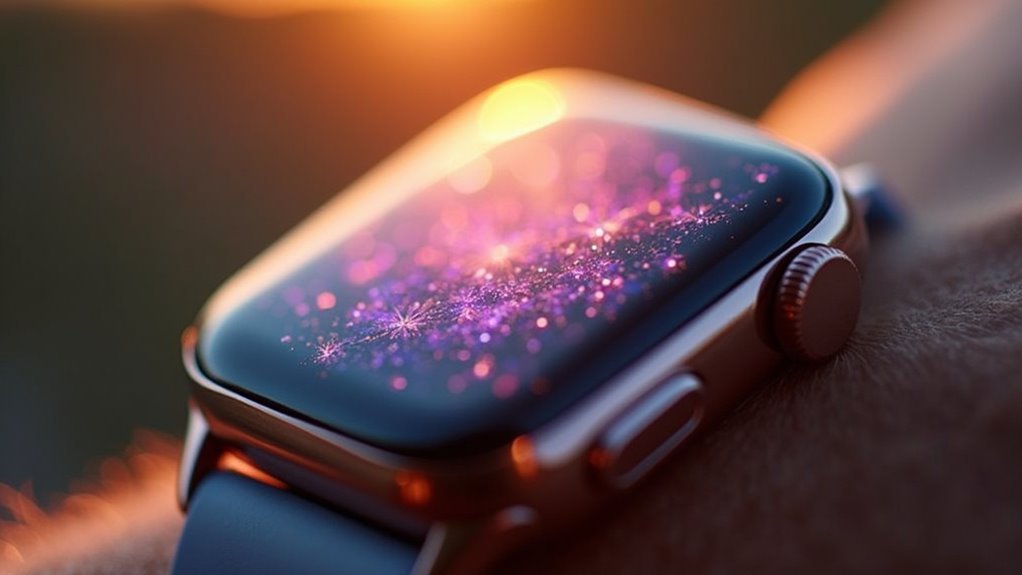
When you’re squinting at your smartwatch under blazing sunlight, the display technology makes all the difference between readable information and a frustrating black screen.
OLED displays deliver bright, vibrant colors with superior contrast ratios that cut through harsh lighting conditions. You’ll find reflective LCDs particularly effective because they harness ambient light to enhance visibility while preserving battery life.
OLED displays cut through harsh lighting with vibrant colors and superior contrast, while reflective LCDs harness ambient light for better battery efficiency.
Ultra Clear AMOLED technology pushes brightness levels up to 1350 nits, ensuring you can read your watch even under direct sun.
JDI Colour Touch Screens, like those in the SkyCaddie LX2, provide all-conditions visibility through their sunlight-readable design. Transflective LCDs combine both backlit and reflective modes to maximize efficiency across varying light conditions.
Always-on displays let you check essential information without activating the screen, combining convenience with power efficiency for outdoor activities.
How Ambient Light Reflection Powers Sunlight Readability
Your smartwatch’s reflective display harnesses ambient light by bouncing it off specialized reflective layers instead of generating its own illumination.
This reflective layer technology eliminates the need for power-hungry backlights, markedly reducing your device’s energy consumption by up to 90%.
You’ll notice your battery lasts considerably longer while maintaining crystal-clear visibility even in bright sunlight.
The liquid crystals between glass layers control light transmission, reflecting light back to your eyes for optimal image formation.
Reflective Layer Technology
Behind your smartwatch’s LCD lies a specialized reflective layer that transforms sunlight from your display’s enemy into its greatest ally. This highly reflective material—typically metal or specialized reflector film—bounces ambient light back through your screen’s pixel layers directly to your eyes.
Unlike traditional backlit displays that struggle against bright sunlight, your smartwatch’s reflective layer harnesses environmental lighting to illuminate the display. The stronger the sunlight, the brighter and clearer your screen becomes. This technology creates consistent visibility by maintaining a fixed contrast ratio through ambient light reflection.
The layer’s engineering balances maximum light return with optical clarity, preventing glare while preserving image sharpness. By eliminating competition against intense sunlight, your reflective display remains perfectly legible when conventional screens wash out completely. This efficiency translates to exceptional battery life, as reflective displays consume at least ten times less power than traditional backlit screens.
Power Consumption Benefits
While conventional smartwatch displays drain your battery fighting against bright sunlight, reflective displays actually reduce power consumption as outdoor lighting intensifies. You’ll find that ambient light sensors automatically adjust your display’s brightness based on environmental conditions, minimizing unnecessary backlight usage.
| Feature | Benefit |
|---|---|
| Ambient Light Integration | Reduces backlight power by 40-60% |
| Adaptive Brightness | Extends battery life by 2-3 hours |
| Reflective Technology | Eliminates continuous backlighting needs |
| Sensor Efficiency | Uses <1mA power consumption |
| Auto-Adjustment | Prevents manual brightness changes |
Your smartwatch’s ambient light sensors, like the OPT3006, consume minimal power while accurately measuring surrounding light. This means you’re getting ideal visibility without excessive energy drain, making your device more efficient in bright outdoor conditions. These sensors collect light intensity variations that enable precise environmental adjustments for optimal display performance.
Power Efficiency Trade-offs in Outdoor Display Performance
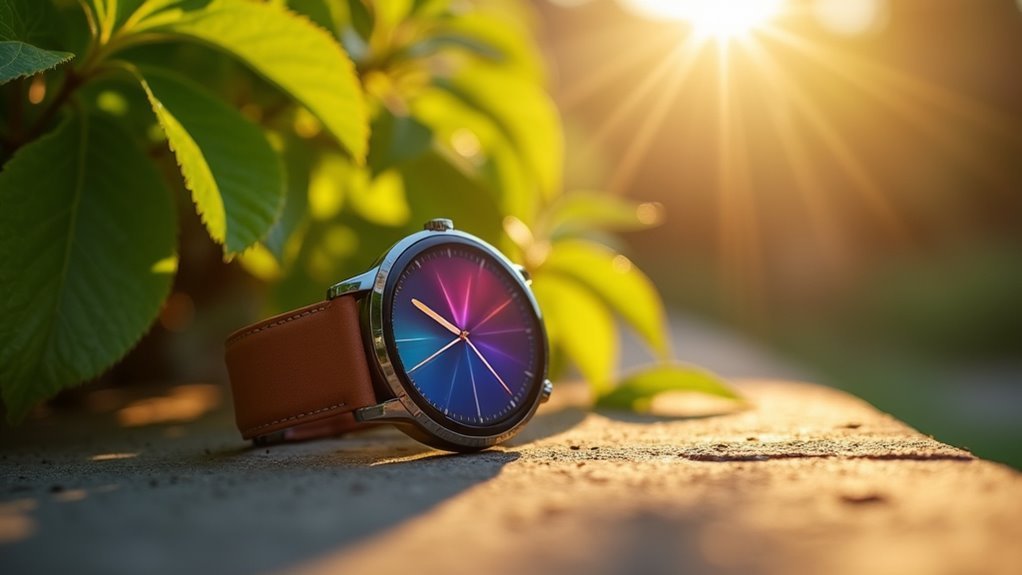
When you’re using a smartwatch outdoors, you’ll face an immediate trade-off between display brightness and battery life. Higher brightness improves readability under sunlit conditions but directly drains your battery faster.
You’ll find that OLED displays, while offering vibrant colors, struggle with sunlight visibility and typically require maximum brightness settings that consume significant energy.
Transflective and Memory LCD technologies help you overcome this challenge by utilizing ambient light for illumination, reducing your reliance on power-hungry backlighting.
Transflective displays leverage natural sunlight to illuminate the screen, dramatically reducing battery drain compared to traditional backlit technologies.
You can extend usage time through power-saving modes that dim or temporarily disable backlighting during outdoor activities. E Ink screens provide high visibility in sunlight with minimal power consumption, making them particularly effective for extended outdoor use.
Modern processors like Snapdragon W5+ Gen 1 optimize energy efficiency through better workload management, while exercise modes selectively limit display refresh rates when full brightness isn’t necessary during long workouts.
User Interface Features That Enhance Daylight Visibility
You’ll find that always-on displays keep essential information visible without requiring wrist gestures that can be awkward in bright conditions.
Your smartwatch’s adjustable brightness controls become vital when you’re moving between shaded and sunny areas throughout your outdoor activities.
Most modern devices include dedicated outdoor modes that automatically optimize screen settings, increase contrast, and simplify interfaces for maximum daylight readability. Advanced JDI Colour Touch Screen technology further enhances visibility by maintaining crisp display quality even in direct sunlight conditions.
Always-On Display Benefits
Since smartwatches spend most of their time displaying static information, always-on display (AOD) technology transforms how you’ll interact with your device under bright sunlight.
You’ll instantly access critical information without tapping or raising your wrist, eliminating the frustration of washed-out screens when you need them most.
AOD’s minimalistic design prioritizes high-contrast elements—bright digits on black backgrounds—that cut through glare effectively.
OLED technology powers off black pixels entirely, creating deeper contrasts while consuming minimal battery. Adjustable refresh rates further reduce power consumption during periods of inactivity, extending battery life while maintaining display visibility.
You can customize widgets to show only essential data, reducing visual clutter that hampers outdoor readability.
Real-time notifications, navigation cues, and music controls remain persistently visible, supporting hands-free operation during activities like cycling or walking.
This continuous visibility enhances safety while maintaining the convenience you expect from modern smartwatch technology.
Adjustable Brightness Controls
While always-on displays provide constant visibility, your smartwatch’s adjustable brightness controls offer the precision needed to combat intense sunlight conditions.
You can manually increase brightness to maximum levels through settings menus by tapping and dragging sliders. Auto-brightness sensors detect ambient light and adjust dynamically, though you can toggle this feature on or off based on preference.
Beyond brightness, you’ll benefit from contrast and color adjustments. High contrast modes and white backgrounds improve text clarity against bright outdoor environments. Memory in Pixel screens provide exceptional outdoor visibility when exposed to direct sunlight.
Font size enlargement aids daylight readability. Quick access controls through swipe-down menus or hardware buttons let you rapidly adapt when moving between lighting conditions.
Some watches include preset “Outdoor Mode” settings for immediate maximum visibility during athletic activities.
Outdoor Mode Features
Most smartwatches include dedicated outdoor modes that fundamentally transform the user interface for ideal daylight visibility.
These specialized modes automatically detect environmental conditions and adapt your watch’s display accordingly. You’ll benefit from enhanced contrast ratios, modified color schemes, and optimized brightness levels that work specifically with natural sunlight rather than fighting against it.
Key outdoor mode features include:
- Transflective displays that reflect sunlight to boost readability without draining battery
- High contrast modes with stark color differences for crystal-clear text visibility
- Auto-switching capabilities that detect bright conditions and adjust settings instantly
- Customizable action buttons for quick access to essential outdoor functions
- Night vision preservation modes using red screens to maintain low-light adaptation
Advanced outdoor watches feature MIP transflective technology that remains clearly visible even in direct sunlight conditions. These intelligent adaptations guarantee you’ll never struggle to read critical information during outdoor activities.
Recent Innovations in Sunlight-Readable Display Technology
As smartwatch manufacturers compete to solve the age-old problem of screen visibility in bright sunlight, they’ve introduced several groundbreaking display technologies that dramatically improve outdoor readability.
You’ll find OLED and AMOLED displays now offer vibrant colors with enhanced sunlight visibility, while micro LED technology promises even brighter screens in concept devices.
E-paper displays take a different approach, using reflective technology that’s naturally sunlight-readable and less distracting. The always-on e-paper technology pioneered by devices like Pebble continues to influence modern smartwatch design with its superior outdoor visibility.
Flexible displays are emerging as game-changers, allowing curved screens that conform to your wrist for better visibility angles.
DPD technology enhances these innovations through precise ambient light sensing, automatically adjusting brightness and maintaining color accuracy.
These advances collectively transform your outdoor smartwatch experience, making screens readable regardless of lighting conditions.
Performance Metrics and Real-World Brightness Capabilities
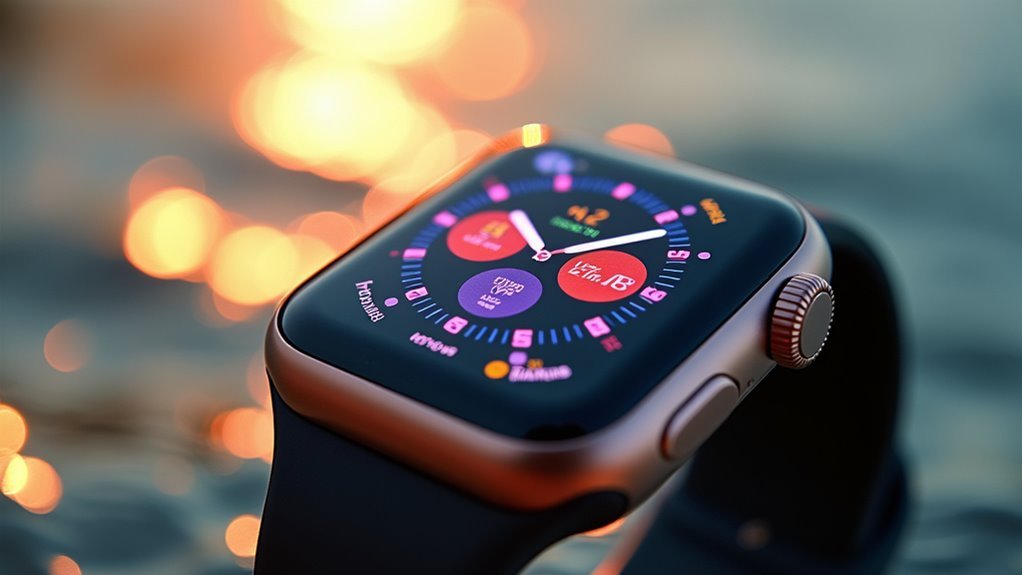
Understanding your smartwatch’s brightness capabilities requires examining specific performance metrics that determine real-world visibility. Modern smartwatches typically deliver 200-1000 nits, but exceptional sunlight readability demands over 1000 nits combined with strategic features.
Key performance metrics include:
- Brightness levels: Industrial-grade devices reach 1500 nits for excellent sunlight visibility
- Contrast ratios: Above 1000:1 ratios make content stand out against reflections
- Viewing angles: Wide-angle displays maintain readability regardless of wrist position
- Response time: 5-8ms guarantees smooth screen updates during outdoor activities
- Adaptive brightness: Ambient light sensors automatically optimize display luminance
Your watch’s “Outdoor Mode” automatically boosts brightness and contrast when sunlight’s detected.
However, brightness alone isn’t sufficient—anti-reflective coatings, optical bonding, and transflective technology work together to combat washed-out visuals caused by environmental reflections. Monochrome displays provide superior contrast in bright sunlight compared to OLED technology, making them ideal for outdoor visibility.
Choosing the Right Display Technology for Outdoor Activities
While brightness specifications matter, your choice of display technology fundamentally determines how well you’ll read your smartwatch during outdoor adventures. Each technology offers distinct advantages depending on your specific activities and requirements.
| Display Type | Sunlight Performance | Power Efficiency | Best Use Case |
|---|---|---|---|
| E Ink | Excellent | Very High | Simple notifications |
| Memory LCD | Very Good | High | GPS navigation |
| Transflective LCD | Good | High | All-day outdoor use |
| OLED | Fair | Medium | High-resolution needs |
| Micro LED | Excellent | Medium | Extreme brightness |
You’ll find E Ink displays excel in direct sunlight but lack color vibrancy. Memory LCDs balance efficiency with readability, making them ideal for healthcare monitoring and sports tracking. Transflective LCDs reflect ambient light while maintaining color capabilities, perfect for extended outdoor sessions. Samsung’s latest smartwatches feature Micro LED technology that delivers exceptional brightness levels for superior outdoor visibility.
Frequently Asked Questions
Do Polarized Sunglasses Affect Smartwatch Display Visibility Outdoors?
Yes, polarized sunglasses can make your smartwatch display appear dark or completely black outdoors. The polarizing filters interfere with each other, blocking the LCD screen’s light from reaching your eyes effectively.
Can Screen Protectors Reduce Sunlight Readability on Smartwatch Displays?
Screen protectors can reduce your smartwatch’s sunlight readability if they’re thick, glossy, or made from light-scattering materials. However, high-quality protectors with excellent optical clarity won’t greatly impact visibility outdoors.
How Does Sweat or Water Impact Display Clarity in Bright Conditions?
Sweat and water create a refractive layer on your screen that scatters sunlight, causing blurry text and glare spots. You’ll notice reduced contrast and irregular reflections that make content harder to read outdoors.
What’s the Ideal Viewing Angle for Reading Smartwatches in Direct Sunlight?
You’ll get best readability by holding your smartwatch nearly perpendicular to the display, angling it slightly toward the sun for reflective screens or away to minimize glare on AMOLED displays.
Do Darker Watch Band Colors Help Reduce Glare Around the Display?
You’ll find darker watch bands can reduce glare by creating visual contrast against your display’s brightness. They help isolate the screen from surrounding reflections, making it easier to read in bright conditions.
In Summary
You’ll find that choosing the right smartwatch display for outdoor use depends on your specific needs. If you’re frequently active in bright sunlight, you’ll want transflective or e-paper technology for maximum readability. OLED displays offer vibrant colors but require higher brightness settings that drain your battery faster. Consider features like automatic brightness adjustment and high-contrast interfaces. Don’t forget to check real-world brightness ratings before you make your purchase decision.

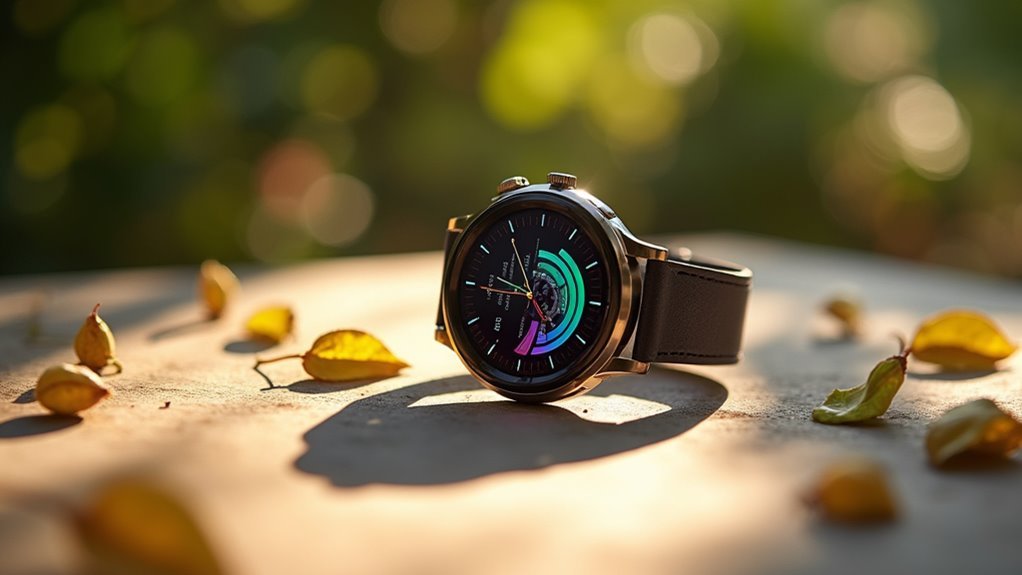
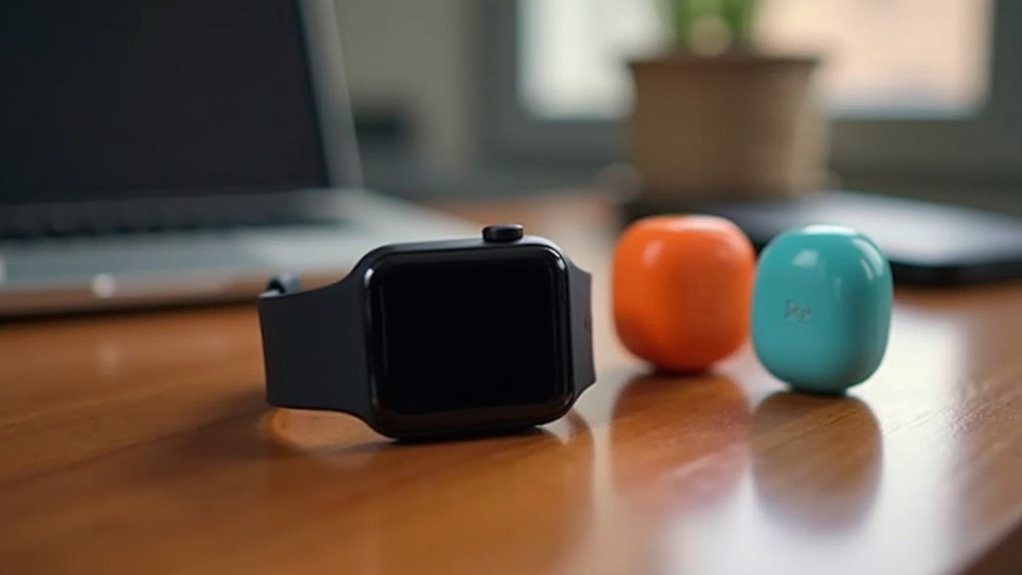
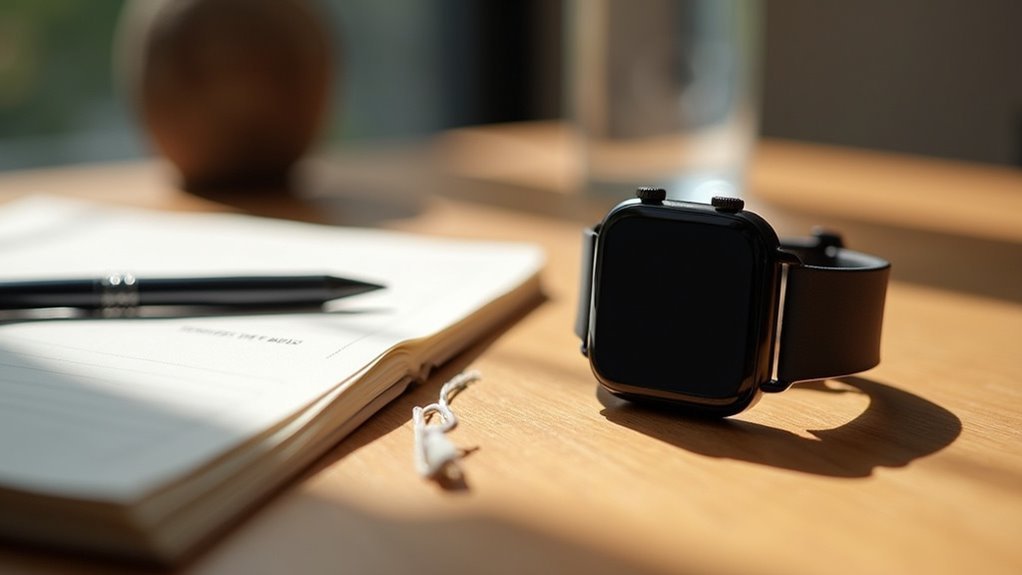
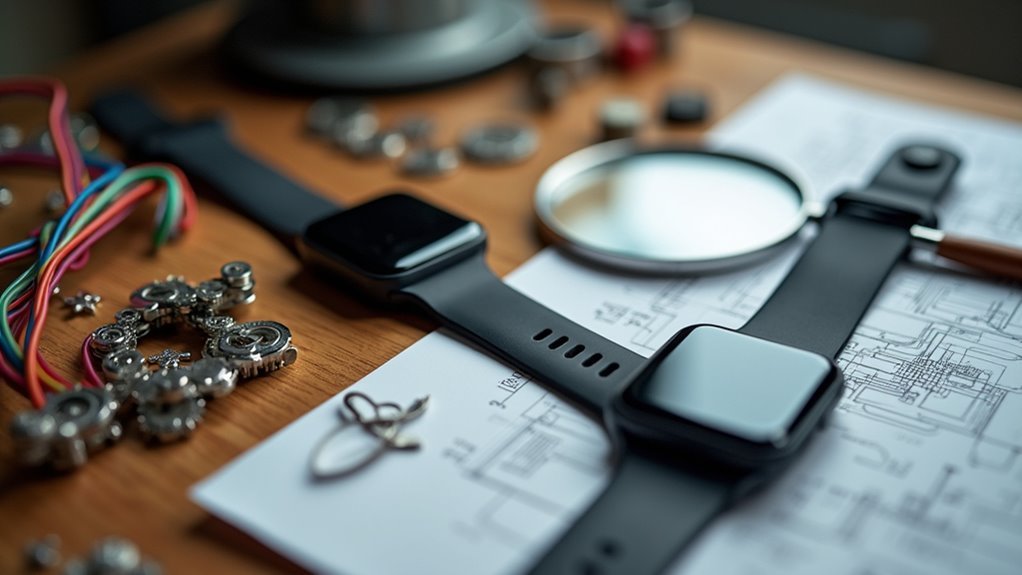
Leave a Reply